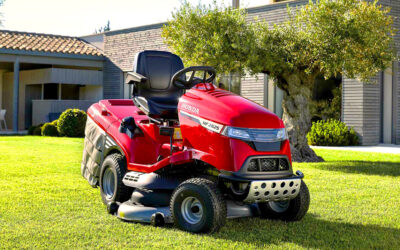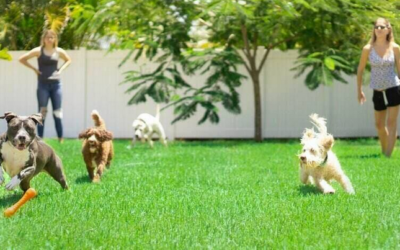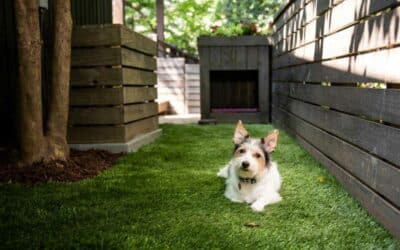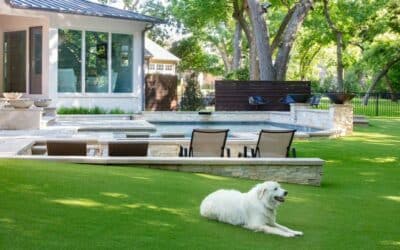If you’ve just made the switch from natural grass and are wondering how to take care of artificial grass with pets, the good news is that some of the work may have been done for you when it was installed.
With a professional installation, your dog or cat can pee on the grass without too many fears of nasty odors accumulating or tell-tale yellow rings forming.
The bad news is that you’ll still have to pick up the poop — but you probably knew that already.
Artificial turf is an investment that can pay you back for many years if you take a few basic artificial lawn care steps. This will keep it verdant, lush and safe for your pets all year round.
Here’s what pet owners need to know about maintaining synthetic grass…

Why artificial grass works for pets AND homeowners
Homeowners in the Dallas-Fort Worth area are increasingly making the switch to artificial grass because of its low maintenance requirements and many other reasons. Keeping a lawn “clean and green” takes virtually no effort (or expense) compared with real grass.
A tiny fraction of the water is needed — and no mowing, trimming, aerating, seeding, fertilizing or herbicides or weedkillers are required.
However, some homeowners hold back on installing synthetic turf because of their pets.
Around two-thirds of U.S. households (almost 87 million homes) own a pet. This includes 65 million homes with dogs and 46.5 million households with cats.
That’s a lot of paws itching to get out in the yard — but how will your artificial lawn stand up to the test?
Replacing natural grass with artificial grass will mean:
- No yellowing or discoloring: when splashed with dog or cat urine, artificial grass is unaffected whereas real grass may turn yellow from the nitrogen content.
- No drainage problems: High-quality artificial grass with a porous backing installed by knowledgeable professionals allows pet urine to drain away.
- No muddy paws trailing through the house: even after a Texan storm, there’s no mud so your pet won’t need a bath after it rains on them in the yard.
- No digging up holes: dogs love searching for mystery bones or long-lost balls but you don’t have to worry about digging with artificial grass.

That’s all great for homeowners but what about your pets? Don’t fear….they’ll love it too. Here’s why:
- It feels just like the real thing: soft and inviting, artificial grass now closely resembles real grass and your pet won’t notice the difference.
- Safety from toxic chemicals: your pet can play in the yard without exposure to toxins in fertilizers, weedkillers, pesticides, etc.
- No grounding after it rains: pets can use artificial grass areas all year round because of the lack of mud after rains, so there’s no need to stay in the house.
- Fewer bugs, ticks and fleas: artificial grass doesn’t have organic debris to trap bacteria and attract bugs, ticks and fleas that can harm your pet (allergies, diseases, etc.)
- True and even surfaces: if you have a dog that loves playing on the lawn, chasing a ball or whatever, the perfectly flat and even surfaces of artificial grass make it safe and fun.
- Easy for small pets: an overgrown grass lawn can be a problem for little paws but small pets can navigate artificial grass surfaces with ease (they’re never overgrown).

For these reasons and more, the high-quality pet turf systems from DFW Turf Solutions have been in high demand in pet centers as well as residential yards in the Dallas-Fort Worth area.
How to maintain artificial grass with pets
Your pet can do its business on artificial grass the same as natural grass but you’ll need to perform a few basic lawn care steps to keep things hygienic.
Artificial grass requires very little maintenance but it doesn’t maintain itself. If you have pets, perform regular checks for any unwanted matter. This is especially important if your children or the rest of the family use the lawn for picnics or play areas.
Just like with real grass, the mess from a dog or cat needs cleaning up quickly or it will smell and attract unwanted visitors. But at least there’s no mowing, fertilizing, weeding — and very little watering required.
Here are a few tips on how to take care of artificial grass with pets…
Removing poop
Scoop up solid pet poop immediately or as quickly as possible with a pooper scooper or tissues. You don’t want it hanging around on your artificial grass and attracting flies.
If any residue remains, clean it off with wet wipes, tissue or spray it with a garden hose. The water and residue will drain away if your artificial grass has been professionally selected and installed.
If the pet poop has been there a while and hardened, it may have stuck to the grass fibers. You may need to spray the area with water before cleaning it off with a scoop or tissue. Use a simple soap and water mix or dish detergent if necessary. For extra certainty, you can treat it with a bacterial enzyme.
The more pets you have, the more important a little prompt and regular maintenance becomes.

Dealing with dog pee
Dog pee drains away from synthetic grass in much the same way as it does with natural grass.
During professional artificial grass installations, your installation team will prepare the ground for good drainage beneath the grass “carpet”.
Infill material is added to the grass surface to help its appearance resemble real grass but it also keeps things hygienic because it’s antimicrobial.
This helps ensure that unwanted odors are prevented. However, you can also rinse the installation down from time to time. Dogs often pee in the same spots daily, so occasionally hosing down these areas is good practice too.
If you have any odor problems from pet pee, scrub the area down with a scrub brush and soapy water. Let it sit a while and rinse it off. A mix of bicarbonate of soda and vinegar sprayed onto the area should also get rid of any smells without harming your pet. Off-the-shelf artificial turf deodorizers like K9-Zap will also eliminate pet odor effectively.
Cleaning other debris
Cleaning any debris that could attract bacteria or unwanted flies and fleas is good general care for your artificial lawn.
Do regular inspections of your lawn area, especially after storms. Clear leaves, twigs, soil, etc. by hand or use a leaf blower or a soft-pronged rake (no metal tines).

Vacuuming
Vacuuming an artificial turf area is another great way to remove pet hair and other fine debris that accumulates over time.
For most smaller areas (less than 1,500 square feet) you can use a normal household vacuum cleaner without a beater bar or stiff bristle brush. These can damage the grass fibers and cause unnecessary wear and tear.
Before vacuuming, check the grass for any loose or damaged fibers as you don’t want to worsen any damage. If in doubt, use a brush, soft rake, leaf blower or other method of maintaining your pet turf.
For larger artificial lawns, you may want to call a professional to help out with a commercial vacuum cleaner.

Occasional hose down
It’s a good idea to hose down your lawn from time to time — more often if you have a small lawn or more than one pet peeing in the same spot on the lawn daily.
Your yard will still look green and pristine without the water but an occasional rinse clears any lingering odors, as well as dust and smaller debris like pet hairs. During drier times, there’s little rain to wash it away.

Cross brushing
Cross brushing is the practice of brushing your lawn against the direction of the nap of the turf fibers. This will fluff and perk the blades up so that your lawn looks fresh and inviting.
It’s good to do this to any artificial lawn now and again, especially if your pet likes to lie in the same place in the yard every day after or after heavy usage from your family.

Is there special artificial grass made for pets?
There is a bewildering array of artificial turf products to choose from nowadays. It’s not all created equal and you should talk your needs through with a professional.
Pet owners need a system designed especially to stand up to their furry friends and last long whatever their pet cat, dog or rabbit throws at it!

The pet turf systems from DFW Turf Solutions are installed in a similar way to all artificial grass spaces — but with some additional measures to ensure hygienic conditions and longevity.
Real grass has a natural drainage system that helps clear pet urine and odors with rainfall or when watering the area. With artificial grass, how well the area drains will be down to the knowledge and skills of your installation team.
The turf should be high quality, installed with a sand-free sub-base (silica retains uric acid crystals in pet urine, which can lead to odors) and provide adequate drainage in its backing to allow all fluids to rapidly drain.
At DFW Turf Solutions, we use pet turf with a drainage rate of 30+ inches of rain per hour per square yard. It’s latex-free with a polyurethane backing that has enough perforations to handle the expected volumes of liquid. Our team is well used to the Dallas climate as well as the needs of pet owners when advising on the appropriate turf to use.
Here’s one of our recent installations in the Dallas-Fort Worth area:

The infill for artificial grass is usually made from crumb rubber, sand and/or silica granules. For pet owners, it’s best to use a sand-free, antimicrobial infill to prevent ammonia, nitrates and bacteria from being trapped and nasty odors forming.
Additionally, weed barriers should not be used under pet turf because they can trap odors. Most artificial grass weeds grow from the infill rather than up through the soil and sub-base anyway, so this won’t adversely affect you.
Are there any downsides to pet turf?
Installing high-quality turf with a professional team can solve many problems for pet owners, as we’ve seen.
However, synthetic grass isn’t for everyone. It may not be right for you if:
- You’re not prepared to pay the higher upfront costs of synthetic grass: it costs $8-12 per square foot to install artificial grass compared with $1-2 per square foot for natural grass; the payback comes later with low water usage and lower maintenance costs.
- You select low-quality artificial grass with toxic components: cheaper imported artificial grass may be made with toxic chemicals such as lead and cadmium. This may make it unsuitable for dogs and your family.
- You choose lower quality grass that overheats easily: in strong sunlight, some cheaper imported grasses heat up excessively and make it uncomfortable for pet paws.
- You choose lower-quality grass that is not durable: unless your turf is strong enough to withstand the wear and tear from pet paws and claws, it may become damaged.
The pet turf installed by DFW Turf Solutions is all high-quality, toxin-free grass that doesn’t overheat and is made for the Texan climate. Your pets will love it almost as much as you do!
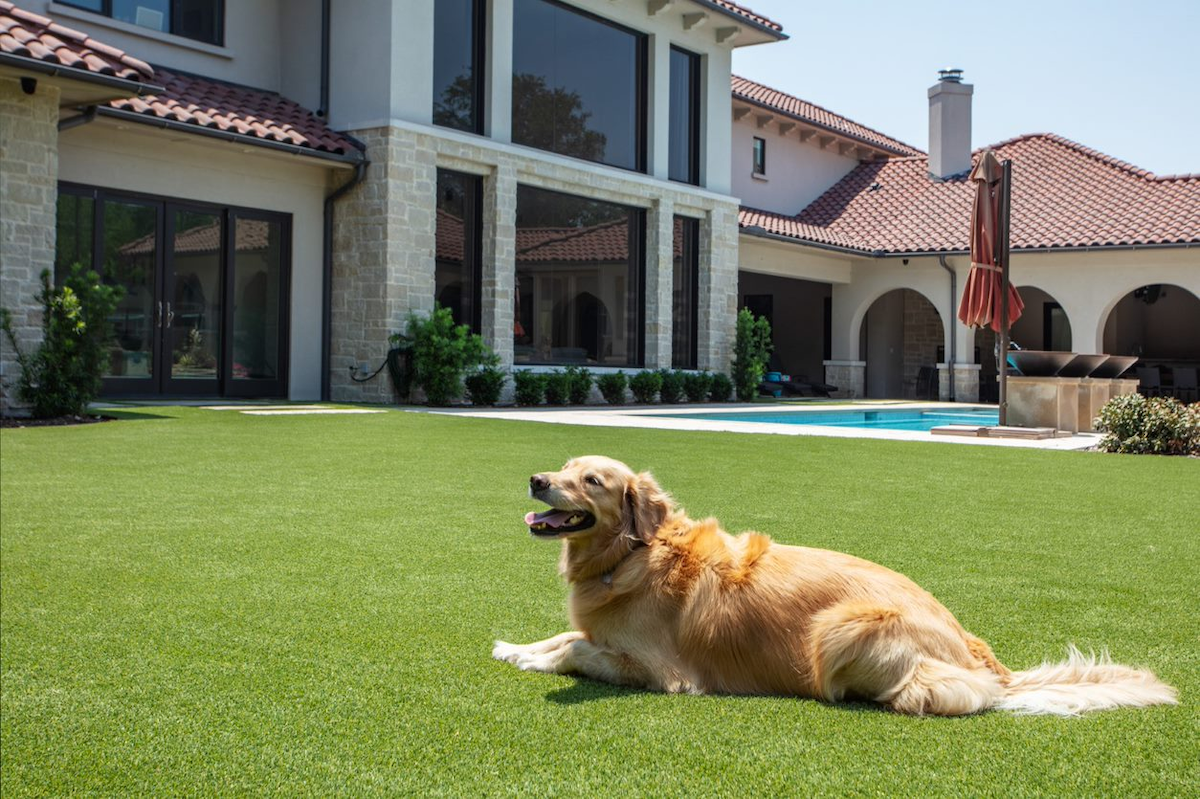
Can pet turf be used in pet hotels?
Artificial turf is much used in dog kennels, pet hotels and dog parks across the U.S. For instance, this dog park in the Dallas-Fort Worth area was installed by the DFW Turf Solutions team:

With many pets to look after, these types of commercial operations need hard-wearing synthetic grass that can withstand the rough and tumble of paws, claws and teeth. They also don’t want their premises dug up by dogs looking for imaginary bones!
That’s why they demand high-quality synthetic grass and come to us.
FAQs
Is artificial grass durable enough for your pet?
High-quality pet turf installed by professionals should last 10-15 years even with pets and the hot Texan sun to deal with.
Can pets poop on artificial grass?
Yes, pets can poop on artificial grass if you clean up promptly afterward — just as you would do with a real grass lawn. You want to keep the area hygienic, especially if children use the yard as well as your dog but it’s no more difficult to do so than with a natural grass lawn.
Is artificial grass safe for pets?
Synthetic turf is perfectly safe for pets provided you select good quality, non-toxic grass from a professional supplier/installer. There are no pesticides, herbicides, mulch or fertilizers required, which instantly means fewer chemicals to cause pet allergies or reactions.
Artificial grass does get hotter than real grass in the summer months but the grass we install is made for the Texan climate and never overheats.
Our grass is also non-toxic for pets and remains safe for all the family. Cheap, imported pet turf that seems “too good to be true” may not be labeled with all of its components and contain some nasties that you don’t want your pet or family exposed to.
Professionally installed pet turf
Artificial grass and pets generally mix well but when you’re sourcing turf and getting estimates, make sure you compare like with like. The quality varies and not all “pet turf” is fit for purpose.
As one of the best-reviewed suppliers and installers of pet systems in the Dallas-Fort Worth area in the last decade, DFW Turf Solutions can promise you quality and service.
We’ve looked after many installations in pet lovers’ yards and can help you select the right pet turf, install it to do its job properly and advise you on the appropriate lawn care. To learn more and get a free quote, call 940-365-9165.

